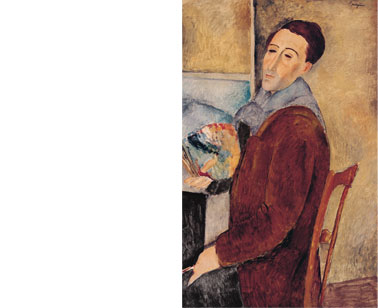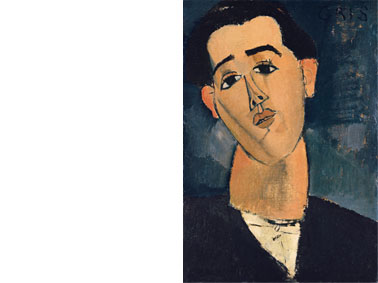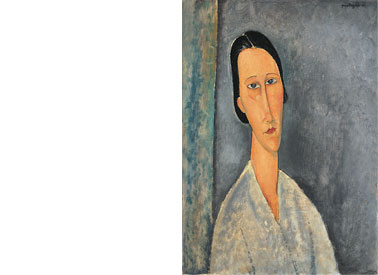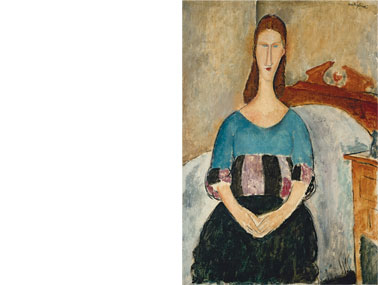

Portraits (I)
The outbreak of World War I placed Modigliani in a difficult situation. In addition to the problem of how to launch his sculptures on the market, the fact that the construction industry was paralysed made it impossible for him to find blocks of stone to work. Moreover, his delicate health meant that he was increasingly sensitive to the stone dust that irritated his lungs. When the writer Max Jacob introduced Modigliani to the art dealer Paul Guillaume that summer of 1914, the artist had not yet completely abandoned sculpture. However, he opted for painting and thus embarked on his future development as a portraitist.
Modigliani's earliest portraits of 1914 still reveal the influence of Fauve colour. Next follow works in which the Cubist approach to spatial organisation prevails. In 1917 Modigliani formulated his mature style characterised by a synthesis of line and volume. In contrast to other 20th-century artists such as Derain, Picasso, and Gris, Modigliani always maintained a balance in his representations between the formal structure of the work and a faithful depiction of the sitter's particular appearance. Among the most important pictures on display in this exhibition are those of the painters Diego Rivera and Juan Gris, the Jewish writer Max Jacob, Madame Zborowska, and Modigliani's lover Jeanne Hébuterne.
The outbreak of World War I placed Modigliani in a difficult situation. In addition to the problem of how to launch his sculptures on the market, the fact that the construction industry was paralysed made it impossible for him to find blocks of stone to work. Moreover, his delicate health meant that he was increasingly sensitive to the stone dust that irritated his lungs. When the writer Max Jacob introduced Modigliani to the art dealer Paul Guillaume that summer of 1914, the artist had not yet completely abandoned sculpture. However, he opted for painting and thus embarked on his future development as a portraitist.
Modigliani's earliest portraits of 1914 still reveal the influence of Fauve colour. Next follow works in which the Cubist approach to spatial organisation prevails. In 1917 Modigliani formulated his mature style characterised by a synthesis of line and volume. In contrast to other 20th-century artists such as Derain, Picasso, and Gris, Modigliani always maintained a balance in his representations between the formal structure of the work and a faithful depiction of the sitter's particular appearance. Among the most important pictures on display in this exhibition are those of the painters Diego Rivera and Juan Gris, the Jewish writer Max Jacob, Madame Zborowska, and Modigliani's lover Jeanne Hébuterne.

Amedeo Modigliani
Self-Portrait, c. 1919
Oil on canvas. 100 x 64.5 cm
Museu de Arte Contemporânea da Universidade de São Paulo

Amedeo Modigliani
Juan Gris, 1915
Oil on canvas. 54.9 x 38.1 cm
The Metropolitan Museum of Art, New York
Bequest of Miss Adelaide Milton de Groot (1876-1967), 1967
© 2007. Image copyright The Metropolitan Museum of Art/Art Resource/Scala, Florence
Juan Gris, 1915
Oil on canvas. 54.9 x 38.1 cm
The Metropolitan Museum of Art, New York
Bequest of Miss Adelaide Milton de Groot (1876-1967), 1967
© 2007. Image copyright The Metropolitan Museum of Art/Art Resource/Scala, Florence

Amedeo Modigliani
Madame Zborowska, 1918
Oil on canvas. 64.5 x 46 cm
Tate. Bequeathed by Mrs. A.F. Kessler, 1983
© Tate, London 2007

Amedeo Modigliani
Portrait of Jeanne Hébuterne, Seated, 1918
Oil on canvas. 54 x 38 cm
Collection, the Israel Museum, Jerusalem
Gift of Stella Fischbach, New York, to American Friends
of the Israel Museum, in memory of Harry Fischbach
Photo © The Israel Museum, Jerusalem/Yoram Lehmann
Portrait of Jeanne Hébuterne, Seated, 1918
Oil on canvas. 54 x 38 cm
Collection, the Israel Museum, Jerusalem
Gift of Stella Fischbach, New York, to American Friends
of the Israel Museum, in memory of Harry Fischbach
Photo © The Israel Museum, Jerusalem/Yoram Lehmann














